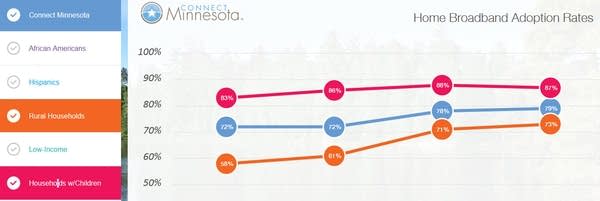Minnesota’s rural broadband gap shrinks
Minnesotans' use of broadband continues to rise slowly -- 79 percent of households say they subscribe to a broadband service, up a percentage point from a year earlier and up 7 points from 2010.
The gap between rural adoption and the state's overall number has closed over the past three years, the latest annual survey of high-speed Internet use shows. Seventy-three percent of rural households subscribe, up from 58 percent three years ago.

(Explore the survey results here.)
Create a More Connected Minnesota
MPR News is your trusted resource for the news you need. With your support, MPR News brings accessible, courageous journalism and authentic conversation to everyone - free of paywalls and barriers. Your gift makes a difference.
The data come from a random telephone poll conducted by Connect Minnesota, the organization charged with tracking high-speed Internet use.
The survey, conducted in November, December and January, tallies how many people actually subscribe to a service at home. That's not to be confused with geographic availability and access, which Connect Minnesota also tracks separately.
Households with school-age children are more likely to subscribe to broadband services, but more than 100,000 children in the state do not have high-speed Internet access at home. Advocates of greater broadband deployment and adoption cite some students' inability to do homework and other education-related work online at home as a significant problem.
The overall gains are encouraging, though it's still worrisome that one in five homes don't have broadband, said Bill Hoffman, project manager for Connect Minnesota. "With just the sheer volume of the economy that's moving online, 20 percent left out is a huge chunk."
Hoffman attributed the faster adoption in rural areas both to education and awareness efforts that have focused on the parts of Minnesota outside the Twin Cities and to expanding availability of high-speed Internet access in some areas.
As in the past, the survey found that among people who don't subscribe to a broadband service, the biggest reason is that they don't consider it relevant to their lives.
At the same time, three out of four of those "non-adopters" say they recognize that it would be easier for them to shop, find health care information or interact with government services if they had Internet access at home.
The state established a goal several years ago that by next year, everyone should have high-speed Internet access available to them. Achieving that seems unlikely. As a result, some lawmakers are pushing for the first time to spend state money to help providers extend on-the-ground service in some areas.
The amount of money proposed was initially $100 million. At this point legislation in the House calls for spending $25 million, but Senate legislation has no money for that purpose.